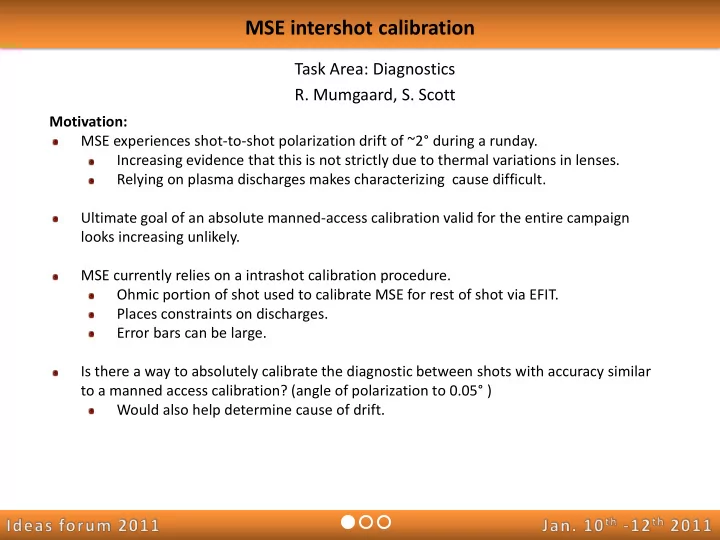

MSE intershot calibration Task Area: Diagnostics R. Mumgaard, S. Scott Motivation: MSE experiences shot-to-shot polarization drift of ~2° during a runday. Increasing evidence that this is not strictly due to thermal variations in lenses. Relying on plasma discharges makes characterizing cause difficult. Ultimate goal of an absolute manned-access calibration valid for the entire campaign looks increasing unlikely. MSE currently relies on a intrashot calibration procedure. Ohmic portion of shot used to calibrate MSE for rest of shot via EFIT. Places constraints on discharges. Error bars can be large. Is there a way to absolutely calibrate the diagnostic between shots with accuracy similar to a manned access calibration? (angle of polarization to 0.05° ) Would also help determine cause of drift.
MSE intershot calibration Calibration requirements: Input polarized light into periscope with a known polarization angle from a known position. Polarization angle to ~0.05° Position to ~mm. Do this for ≥ 2 polarization angles. Repeatable. Upgrade in 2010 shows promise for shutter based polarizers for absolute calibration: New bushing based shutter has precise running clearances at all temperatures. Very little wobble allowed (~0.2°) Could be further decreased by tightening clearances, adding preload. Shutter tested under vacuum at temperatures up to 150 °C before installation. New bushing-based shutter >1600 cycles without evidence of wear. installed in FY10 No problems during this campaign. Existing shutter has space for 3 wire grid polarizers. Would require illumination. Backlight with fibers?
MSE intershot calibration Current status: Conceptual design. Try for installation during up-coming manned access. Expected benefits: Allow more flexibility in discharge planning, no ohmic periods for intrashot calibration. Decrease errors from intrashot calibration. Perhaps help determine cause of shot-to-shot drift. Necessary run time: Mostly between shots. Some shots with shutter closed to determine intra-shot calibration stability. (Piggybacked on shots that don’t request MSE)
Recommend
More recommend